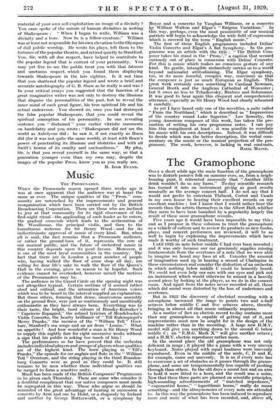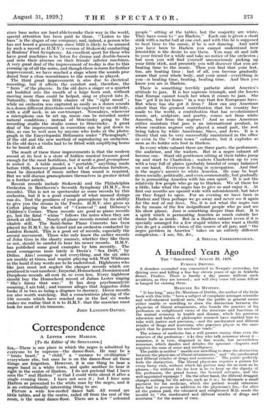The Gramophone
ONLY a short while ago the main function of the gramophone was to disturb pensive folk on summer eves, as, from a neigh- bouring punt, it reiterated raucously that "Another little drink wouldn't do us any harm." To-day scientific research has turned it into an instrument giving as good results musically as the average concert hall. I do not say that I would not prefer to entertain Thibaud, Cortot and Casals in my own house to hearing their excellent records on my excellent machine ; but I know that I would rather hear the records than the artists themselves in the Albert Hall; whither they seem to have been banished by a popularity largely the result of these same gramophone records.
Five years ago it would have been impossible to say this ; and as I propose in these columns to treat the gramophone as a vehicle of culture and to review its products as new books, plays, and concert performers are reviewed, it will be as well to begin by explaining the improvements which have made it worthy of such treatment.
Until 1925 no note below middle C had ever been recorded ; and it was only because our ear graciously supplies missing fundamentals from the overtones of a note that we were able to imagine we heard any bass at all. Consider the amount of imagination used up in hearing a record of Chaliapine in these circumstances and consider the distortion of an orchestra in which nothing below middle C could be honestly heard. We could not even help our ears with our eyes and pick out an instrument which would otherwise be missed in a heavily scored piece by looking at the player, as we do in the concert room. And apart from the notes never recorded at all, those which did sound were distorted by the loss of undertones and overtones.
But in 1925 the discovery of electrical recording with a microphone increased the range to points two and a-half octaves below middle C and five octaves above, thereby bringing in almost all that music ordinarily requires.
As a matter of fact an electric record to-day contains more than any gramophone is capable of getting out of it, and improvements must now be sought for in the design of the machine rather than in the recording. A large new H.M.V. model will give you anything down to the second G below middle C; an " E.M.G. Mark X" will give another octave ; and a H.M.V. electric reproducer rather more.
In the second place the old gramophone was not only deficient in range ; it played like a piano with a very uneven keyboard. Notes played with equal loudness were unevenly reproduced. Even in the middle of the scale, C, D and E, for example, came out unevenly. It is as if every note has to overcome a set of obstacles as it passes through the gramo- phone, and some are temperamentally less capable of pushing through than others. In the old days a sound box and an arm to hold it were fitted to a horn, and the result was a noise. Now that these three parts are planned on scientific principles, high-sounding advertisements of "matched impedance," "exponential horns," "logarithmic horns," really do mean something—and the idiosyncrasies of every note are attended to. In this way the gramophone has been induced to reproduce more and more of what has been recorded, and, above all
since bass notes are least able to make their way in the world, special attention has been paid to them. "Listen to the bass" is the slogan of one company; and, indeed, a person who has not heard a gramophone since 1920 is likely to be amazed by such a record as H.M.V.'s version of Stokowski conducting in Brahms' First Symphony An excellent sport for those who have good machines is to listen for drums and double-basses and note their absence on their friends' inferior machines. A very great deal of the improvement of to-day is due to this evening up of all the notes, and though there is room for further improvement, we have reached a stage where the sounds pro. duced bear a close resemblance to the sounds as played. The third great improvement is also due to electrical recording, but it affects the comfort and, therefore, the " form ' of the players. In the old days a singer or a quartet sat huddled into the mouth of a huge horn and, without moving more than could be helped, sang or played into it. Naturally, there was little chance of the "right mood " ; while an orchestra was captured as easily as a dozen sounds in a dozen different directions could be captured by an old lady, with a stiff neck, in an ear-trumpet. Nowadays, wherever a microphone can be set up, music can be recorded under natural conditions ; instead of Stravinsky going to the recording studio the studio comes to Stravinsky. A great deal of the improvement in execution can be put down to this, as can be well seen by anyone who looks at the photo- graph in the Encycloptedia Britannica under "Phonograph," of the old and the new method of reproducing an orchestra. In the old days a violin had to be fitted with amplifying horns to be heard at all.
The result of these three improvements is that the modern record at its best is a store of hidden musical treasure good enough for the most fastidious, but it needs a good gramophone to unlock it. A table model, a "portable," anything made before 1926, however pleasant as a bit of Jacobean furniture, must be discarded if music rather than sound is required. But we will discuss gramophones- themselves in greater detail in a further article.
Recent records include Stokowski and the Philadelphia Orchestra in Beethoven's Seventh Symphony (H.M.V., five records). This is not so spectacular as some records by this Orchestra, but it is a good example of what massed strings can do. Test the goodness of your gramophone by its ability to give you the drums in the Presto. H.M.V. also gives us Cortot playing the whole of " C,arneval " and Debussy's Children's Corner. These records are good as piano records go, but the fatal " whine " follows the notes when they are struck at all hard. Nearly all piano records remind one of the ukalele still. The Saint-Sa6ns Piano Concerto has been played for H.M.V. by de Greef and an orchestra conducted by Landon Ronald. This is a good set of records, especially the second movement. Those who only know the earlier records of John Goss in the shanty manner, whether they like them or not, should be careful to hear his newer records. H.M.V. has published some good examples by him recently. The most courageous issue lately is Decca's "Sea Drift," by Delius. Alas! courage is not everything, and the six sides are muddy at times, and require playing with Walt Whitman in the hand if any words are to be understood. Highbrows who like jazz must not neglect the cheaper records which are produced in vast numbers: Imperial, Homochord, Dominion and Ouophone records all cost 2s. or even less. Every highbrow should buy the Homochord record of Julian Lester singing "She's funny that way." It has deep psychoanalytic meaning, I am told and rumour alleges that Augustus John broke it in two as being a disgrace to decency. Decca records are also worth watching. But a conscientious playing of the 150 records which have reached me in the last six weeks makes me realize that it is to H.M.V. that the musician must look for most of his treasure.
JOHN LANGDON-DAVIES.

































 Previous page
Previous page